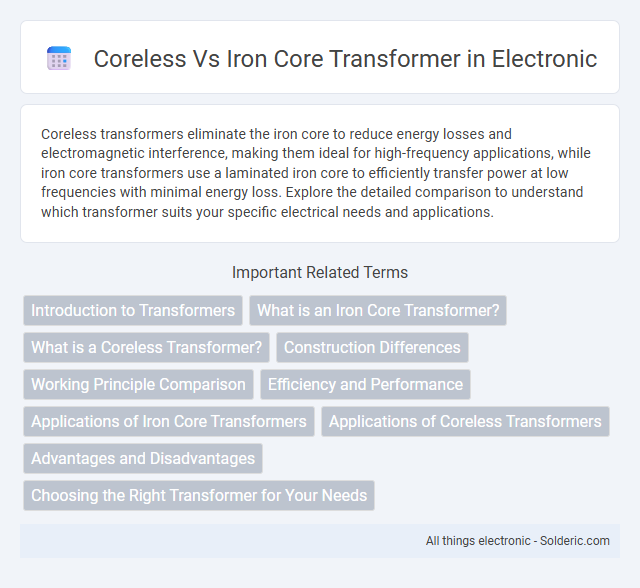Coreless transformers eliminate the iron core to reduce energy losses and electromagnetic interference, making them ideal for high-frequency applications, while iron core transformers use a laminated iron core to efficiently transfer power at low frequencies with minimal energy loss. Explore the detailed comparison to understand which transformer suits your specific electrical needs and applications.
Comparison Table
| Feature | Coreless Transformer | Iron Core Transformer |
|---|---|---|
| Core Material | No magnetic core; air-core design | Ferromagnetic iron core |
| Magnetic Flux | Low magnetic flux density | High magnetic flux density |
| Efficiency | Lower efficiency due to leakage flux | High efficiency (typically 95%+) |
| Frequency Usage | High-frequency applications | Low to medium frequencies (50-60 Hz typical) |
| Size & Weight | Lightweight and compact | Heavier and bulkier |
| Power Rating | Low power levels | High power levels |
| Core Losses | No core losses (no hysteresis or eddy currents) | Core losses present (hysteresis and eddy current) |
| Application | RF transformers, pulse transformers, inductive sensors | Power distribution, voltage regulation, isolation |
| Cost | Generally higher for low power due to specialized design | Cost-effective for power applications |
Introduction to Transformers
Transformers transfer electrical energy between circuits via electromagnetic induction, with iron core transformers using ferromagnetic cores to enhance magnetic flux and improve efficiency. Coreless transformers rely on air or non-magnetic materials, resulting in lower magnetic losses but reduced efficiency and power capacity. Your choice depends on application needs, balancing efficiency, size, and weight for optimal performance.
What is an Iron Core Transformer?
An iron core transformer uses a laminated iron core to channel magnetic flux between primary and secondary windings, enhancing magnetic coupling and reducing energy losses. The iron core significantly improves efficiency by concentrating the magnetic field, enabling higher power transfer compared to coreless transformers. This type of transformer is widely used in electrical power distribution and industrial applications for reliable voltage regulation.
What is a Coreless Transformer?
A coreless transformer is an electromagnetic device that transfers electrical energy between circuits without a magnetic core, relying solely on air or other non-magnetic materials as the medium. This design eliminates core losses such as hysteresis and eddy currents, making it highly efficient for high-frequency applications. Your choice of a coreless transformer can enhance lightweight, compact, and noise-sensitive electronic systems where minimal energy loss is critical.
Construction Differences
Coreless transformers feature a coil design without any magnetic core, relying on air or a non-magnetic medium to transfer energy, while iron core transformers contain laminated iron cores that enhance magnetic flux and improve efficiency. The iron core's construction reduces energy loss by concentrating the magnetic field, whereas coreless transformers experience higher leakage inductance due to the absence of a core. Understanding these construction differences helps you choose the right transformer for applications requiring either lightweight design or high magnetic efficiency.
Working Principle Comparison
Coreless transformers operate based on the principle of air-core inductive coupling, relying on the magnetic field generated by the coil's current without a ferromagnetic core, resulting in lower magnetic losses and minimal inductance. Iron core transformers use a laminated iron core to concentrate and guide the magnetic flux, significantly enhancing the magnetic coupling between primary and secondary windings and improving efficiency. Understanding your application's working principle requirements will help determine whether a coreless or iron core transformer offers the best performance in terms of energy transfer and magnetic interference.
Efficiency and Performance
Coreless transformers offer higher efficiency at high frequencies due to reduced core losses and minimal eddy currents, making them ideal for specialized applications. Iron core transformers generally provide better performance at low frequencies, thanks to their magnetic core that enhances flux linkage, but they suffer from energy losses such as hysteresis and eddy currents. Your choice depends on the operating frequency and efficiency requirements, with coreless designs excelling in lightweight, high-frequency scenarios and iron core transformers favored for traditional power distribution.
Applications of Iron Core Transformers
Iron core transformers are widely used in power distribution systems, electrical substations, and industrial machinery due to their high efficiency and ability to handle heavy loads. Their magnetic cores provide effective flux linkage, making them ideal for applications requiring voltage regulation and energy transfer at various power levels. You can find iron core transformers in household appliances, renewable energy systems, and audio equipment where precise voltage transformation and minimal energy loss are critical.
Applications of Coreless Transformers
Coreless transformers find specialized use in high-frequency and medical applications due to their minimal magnetic core losses and reduced electromagnetic interference. They are favored in precision measurement devices, wireless power transfer, and sensitive instrumentation where low noise and high efficiency are critical. Unlike iron core transformers, coreless transformers excel in compact, lightweight designs ideal for aerospace and portable electronics.
Advantages and Disadvantages
Coreless transformers offer advantages such as reduced eddy current losses and lower weight, making them ideal for high-frequency applications, but they typically have lower magnetic efficiency compared to iron core transformers. Iron core transformers provide superior magnetic flux density and better energy transfer efficiency, which suits power distribution needs, yet they suffer from higher core losses and increased weight. Your choice depends on whether you prioritize efficiency and robustness with an iron core or lightweight design and minimal losses with a coreless model.
Choosing the Right Transformer for Your Needs
Coreless transformers provide benefits such as reduced electromagnetic interference and lightweight design, making them ideal for sensitive electronic applications and compact devices. Iron core transformers deliver higher efficiency and better magnetic flux control, suited for high-power industrial uses and heavy-duty electrical systems. Selecting the right transformer depends on balancing factors like power requirements, size constraints, efficiency needs, and electromagnetic compatibility.
coreless vs iron core transformer Infographic

 solderic.com
solderic.com